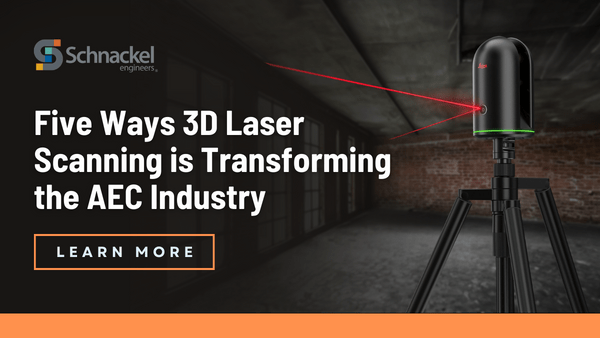Five Ways 3D Laser Scanning is Transforming the AEC Industry

In the ever-evolving realm of architecture, engineering, and construction (AEC), technology’s role has become increasingly pivotal and fast paced. Among the technological advances shaping the industry, 3D laser scanning stands as a true game-changer. This advanced technology has redefined the way we approach design, planning, and execution of construction projects, especially when remodeling existing buildings. In this blog, we’ll delve into the five ways that laser scanning is changing the AEC industry, with a particular focus on its impact on efficiency, accuracy, and project outcomes.
3D Laser Scanning: A Brief Overview
Before delving into the power that 3D laser scanning has to produce better quality drawings, let’s review the basics of this cutting-edge technology. Laser scanning involves the use of lasers to capture precise measurements and create intricate 3D models of existing structures or environments. By emitting laser beams and measuring the time taken for them to return after hitting a surface, laser scanners create a comprehensive point cloud that represents the physical dimensions of the space. Laser point cloud technology has been around for more than a decade now. Laser point clouds, on their own, are of limited utility since they only represent the points of reflection of the lasers, making it very difficult to interpret what is being viewed.
The more advanced scanners of today are able to link the laser point cloud to high-resolution virtual reality photography. This data-rich visual representation forms the foundation for the practical use of this technology for designing buildings
Enhanced Site Analysis
The traditional manual surveying of existing buildings and spaces often leads to inaccuracies, errors and extended project timelines. Laser scanning has dramatically improved the surveying process, enabling professionals to capture an entire site’s dimensions and features with remarkable precision. This data is not only crucial for initial design stages but also for accurate site analysis. By integrating laser scanning into the surveying process, AEC experts can streamline project planning and minimize potential clashes with existing structures.
Efficient As-Built Documentation
Traditionally, documenting as-built conditions was a painstaking process prone to human errors. Laser scanning has transformed this phase by offering an efficient and accurate alternative. Contractors, architects, and engineers can now capture every detail of an existing structure, from intricate architectural features to complex building services systems. This documentation proves invaluable during renovations, retrofits, or expansions, as it reduces uncertainties and guides decision-making based on real-world data.
Seamless Design and Collaboration
The synergy between laser scanning and Building Information Modeling (BIM) is a driving force behind enhanced collaboration and design accuracy. Laser-scanned point clouds serve as a reliable foundation for creating BIM models, ensuring that the digital representation aligns with the physical reality of the space. This conversion to BIM minimizes design errors, clashes, and discrepancies, fostering seamless collaboration among multidisciplinary teams. Architects, engineers, and contractors can collectively refine designs, anticipate challenges, and make informed decisions backed by precise data.
Precision Quality Control
Quality control stands paramount in successful construction projects. Laser scanning introduces a new tool to ensure the accuracy of the construction of projects. By comparing point cloud data to the intended design models, construction project managers can detect deviations and anomalies at an unprecedented level. This proactive approach empowers teams to address issues in real-time, reducing rework, costly delays, and budget overruns. As a result, projects adhere more closely to timelines and budgets, while maintaining high-quality standards.
Construction Safety Enhancement
Project disruptions and safety concerns often go hand in hand during construction. Laser scanning aids in minimizing both. With its non-intrusive nature, laser scanning reduces the need for manual measurements that could disrupt ongoing activities and present increased safety risk to workers. With laser scanning technology, measurements can be made from safe working platforms or areas without the need for ladders or lifts to verify the construction accuracy. Moreover, by providing comprehensive insights into a site’s conditions, including structural elements and MEP systems and supports, laser scanning enhances worker safety. Teams can anticipate potential hazards and develop strategies to mitigate risks, ensuring a safer working environment.
Conclusion
The AEC industry is in the midst of a technological revolution, and 3D laser scanning stands as one example of this transformation. Its impact on efficiency, accuracy, collaboration, and safety is significant. As we embrace the digital transformation of the AEC industry, it’s crucial to stay at the forefront of innovation. To further leverage the potential of laser scanning, explore our Virtual Reality Point Cloud Scanning Technology. This groundbreaking advancement allows you to immerse yourself in your project’s data, unlocking new insights and possibilities.Connect with Schnackel Engineers today to uncover how you can reshape your approach to design, construction, and collaboration. To learn how you can reshape your approach to design, construction, and collaboration. Embrace the future of AEC innovation today.
Comments